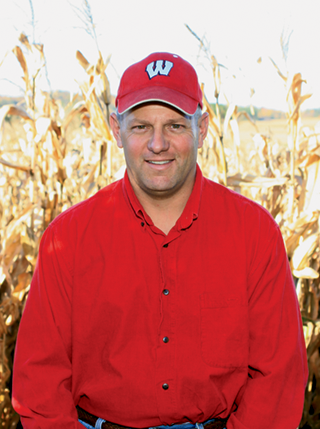The mild winter and early spring conditions we’ve seen may have implications for this season’s weed and pest control.
Weeds are actively growing in fields much earlier, and this may be particularly problematic in no-till fields. Aggressive management of weeds may be needed.
Reducing The Seed Bank
Fields that will receive pre-plant tillage may actually have an advantage this year because more weed seeds than normal may germinate and emerge prior to cultivation. This may reduce the weed-seed bank and reduce emerging weed pressure later in the cropping season.
We can translate this advantage to no-till by letting weeds germinate and surface, but we’ll need to control them before they start competing for nutrients and moisture. No-tillers may have to move up planting or post-emergence applications to pre-plant applications.
Early-season weed competition can reduce yields quickly, so no-tillers should work with their agronomist to review timing of herbicide applications.
Watch Out For Perennials
In no-till systems, a mild winter likely means more winter annual, biennial and perennial weeds are present because winter survival may be higher than normal.
You may have more perennial weeds than normal, so your first herbicide pass should include a burndown at the correct rate and timing to control perennial and emerging annuals.
Additionally, if spring temperatures remain warmer than normal, these increased weed densities may start growing earlier at a more accelerated growth rate. This likely means there will be more, and larger, weeds to control in no-till systems.
Vince Davis, an Extension weed specialist for the University of Wisconsin, points out several major concerns about increased weed pressure:
• Soybean cyst nematodes may have more time to reproduce on winter annual weeds.
• Insects like black cutworms and armyworms may be attracted to these fields more than normal, since moths in flight like to lay eggs in fields with foliage.
• The timing of pre-plant and pre-emergence herbicide applications may be much more important to optimize early-season weed control.
Start Scouting Earlier
In a warm spring, scouting must start earlier and control measures should be taken earlier than normal.
When scouting, carefully identify the weeds you wish to control and select the most appropriate herbicide and adjuvants. Determine spray rates based on weed type, size and growth stage.
When pre-plant herbicides are applied in the spring for control of existing weed vegetation, winter annual weeds are easier to control when they’re actively growing prior to flowering. Additionally, summer annual weeds are easier to control if they’re smaller at application time.
No-tillers should ensure burndown applications are timely. High levels of dead plant residue on the surface can trap early-season soil moisture and reduce soil temperatures, which may delay planting or emergence.
Often in no-till systems, a non-selective burndown herbicide like glyphosate (Roundup PowerMax), paraquat (Gramoxone Inteon) or glufosinate (Liberty) are frequently used.
These herbicides can be tankmixed with 2,4-D to improve broadleaf control prior to corn or soybean planting. The labels of different 2,4-D formulations specify a waiting period between application and crop planting, and they vary by product and amount applied.
Ester formulations of 2,4-D usually have a shorter waiting period between application and planting, and are often preferred over the amine formulation. Most labels of many 2,4-D ester formulations (LV4 or 3.8 pounds acid equivalent per gallon) allow applications of up to 1 pint per acre 7 days prior to soybean planting.
If you wait too long so that higher rates are needed to control tough perennials like alfalfa or dandelion, then increasing the rate to more than 1 pint increases the waiting interval to 30 days.
Keep in mind that some 2,4-D ester formulations also require a waiting interval between application and corn planting (for example, 7 days for up to 1 pint, 14 days for rates between 1 and 2 pints).
Control Beyond Burndown
It’s normally recommended to use a herbicide that provides residual weed control through the first 3 to 5 weeks of early crop growth in a tankmix combination with burndown herbicides.
Many of these herbicides can also aid in burndown control, but often the primary focus of the residual herbicide is to protect yield loss through the early stages of crop growth.
More importantly, this different type of herbicide mode of action helps reduce the likelihood of glyphosate resistance.
Residual herbicides also minimize the number and diversity of plants present when post-emergence herbicides are applied.
To maximize the effectiveness of residuals, apply them close to planting. There isn’t a strict rule on applying burndown or residuals together, based on the timing ahead of planting. But it’s usually beneficial to tankmix them.
However, with a warm spring, increased densities and sizes of weeds may require no-tillers to separate the burndown and residual herbicides — especially for no-tillers terminating winter cover crops like ryegrass.
If you need to apply a burndown herbicide 3 or 4 weeks or more ahead of planting, one strategy may be to apply an early burndown without residual, and a second burndown with a full-rate residual product at the time of planting. This should minimize — and possibly negate — the rate of post-emergence herbicide needed later.
A second strategy may be to apply the residual herbicide with the first burndown application. This will keep fields cleaner and easier to plant into throughout the spring, and possibly allow planting before a second application.
But the post application will likely be needed much earlier than in the previous scenario, and should include another ‘in-crop’ residual application.






